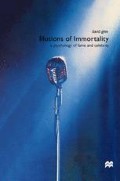Abstract
When we encounter celebrities in real life, our immediate sensation is often one of intense familiarity. We are certain we know that person from somewhere, and a split-second later we feel rather foolish when we realize it is someone we have never spoken to, who is ignorant of our individual existence, yet seems as familiar as a close neighbour or a long-lost friend.
Preview
Unable to display preview. Download preview PDF.
Notes and References
Cantril, H. and Allport, G. (1935) The Psychology of Radio. New York: Harper and Brothers.
Himmelweit, H. T, Oppenheim, A. N. and Vince, P (1958) Television and the child. London: Oxford University Press. A typical example of early ‘television and psychology’ texts.
Gunter, B. (1987) Poor Reception: Misunderstanding and Forgetting Broadcast News. Hillsdale, NJ: Lawrence Erlbaum Associates.
Newhagen, J. E. and Reeves, B. (1992) ‘The evening’s bad news: Effects of compelling negative television news imagery’. Journal of Communication, 42, pp. 25–41.
Comstock, G., Chaffee, S., Katzman, N., McCombs, M. and Roberts, D. (1978) Television and Human Behavior. New York: Columbia University Press.
Harris, R. J. (1991) The Cognitive Psychology of Mass Communication. Hillsdale, NJ: Lawrence Erlbaum Associates.
Condry, J. (1989) The Psychology of Television. Hillsdale, NJ: Lawrence Erlbaum Associates.
Kubey, R. and Csikszentmihalyi, M. (1990) Television and the Quality of Life: How Viewing Shapes Everyday Experience. Hillsdale, NJ: Lawrence Erlbaum Associates.
Noble, G. (1975) Children in front of the small screen. Beverly Hills, CA: Sage.
Granzberg, G. (1985) ‘Television and self-concept formation in developing areas: The central Canadian Algonkian experience’. Journal of Cross Cultural Psychology, 16, p. 323.
Shapiro, M. A. and McDonald, D. G. (1995) ‘I’m not a real doctor, but I play one in virtual reality: Implications of virtual reality for judgments about reality’. In F. Biocca and M. R. Levy (eds) Communication in the Age of Virtual Reality. Hillsdale, NJ: Lawrence Erlbaum Associates, pp. 323–45.
Samuels, A. and Taylor, M. (1994) ‘Children’s ability to distinguish fantasy events from real-life events’. British Journal of Developmental Psychology, 12, pp. 417–27.
A useful reference here is Maire Messenger Davies’ Fake, Fact and Fantasy: Children’s Interpretations of Television Reality (Hills dale, NJ: Lawrence Erlbaum Associates, 1997).
Reeves, B. and Nass, C. (1996) The Media Equation: How People Treat Computers, Television, and New Media Like Real People and Places. Stanford University: Cambridge University Press.
Bianculli, D. (1992) Tele-literacy: Taking Television Seriously. New York: Continuum.
Hodge, B. and Tripp, D. (1986) Children and Television. Cambridge: Polity Press.
Rice, M. L., Huston, A. C. and Wright, J. C. (1983) ‘The forms of television: Effects on children’s attention, comprehension, and social behaviour’. In M. Meyer (ed.) Children and the Formal Features of Television: Approaches and Findings of Experimental and Formative Research. Munich: K. G. Saur.
Stacey, J. (1991) ‘Feminine fascinations: Forms of identification in star-audience relations’. In C. Gledhill (ed.) Stardom: Industry of Desire. London: Routledge, pp. 141–66.
Cohen, J. and Metzger, M. (1998) ‘Social affiliation and the achievement of ontological security through interpersonal and mass communication’. Critical Studies in Mass Communication, 15, pp. 41–60.
Horton, D. and Wohl, R. R. (1956) ‘Mass communication and parasocial interaction’. Psychiatry, 19, pp. 215–29.
Scannell, E (1996) Radio, Television and Modern Life. Oxford: Blackwell, p. 19.
Rubin, R. B. and McHugh, M. E (1987) ‘Development of parasocial interaction relationships’. Journal of Broadcasting and Electronic Media, 31, pp. 279–92.
Rubin, A. M., Eerse, E. M., and Eowell, R. A. (1985) ‘Loneliness, parasocial interaction, and local television news viewing’. Human Communication Research, 12, pp. 155–80.
Cortez, C. A. (1992) ‘Mediated interpersonal communication: The role of attraction and perceived homophily in the development of parasocial relationships’. Doctoral dissertation, University of Iowa.
Eicirillo, M. S. (1986) ‘On the authenticity of televisual experience: A critical exploration of parasocial closure’. Critical Studies in Mass Communication, 3, pp. 337–55.
Leets, L., de Becker, G. and Giles, H. (1995) ‘Fans: Exploring expressed motivations for contacting celebrities’. Journal of Language and Social Psychology, 14, pp. 102–24.
Rubin, A. M. and Rubin, R. B. (1985) ‘Interface of personal and mediated communication: A research agenda’. Critical Studies in Mass Communication, 2, pp. 36–53.
Miller, R. V. (1983) A descriptive study of television usage among older Americans: Refining the parasocial concept’. Unpublished doctoral dissertation, Eennsylvania State University, University Eark.
Doane, M. A. (1987) The Desire to Desire: The Woman’s Film of the 1940s. Bloomington: Indiana University Press.
Oliver, M. B. (1993) Adolescents’ enjoyment of graphic horror’. Communication Research, 20, pp. 30–50.
Apter, M. J. (1982) The Experience of Motivation: The Theory of psychological reversals. San Diego: Academic Press.
Priest, P J. (1995) Public intimacies: Talk Show Participants and Tell-all TV. Cresskill, NJ: Hampton. Similar research has been conducted in a British context by Sonia Livingstone and Peter Lunt (Talk on Television: Audience Participation and Public Debate. Routledge, 1994).
See Marshall (1997) Celebrity and Power: Fame in Contemporary Culture. Minneapolis: University of Minnasota Press.
Copyright information
© 2000 David Giles
About this chapter
Cite this chapter
Giles, D. (2000). Fame and the ‘general public’. In: Illusions of Immortality. Palgrave, London. https://doi.org/10.1007/978-1-137-09650-0_4
Download citation
DOI: https://doi.org/10.1007/978-1-137-09650-0_4
Publisher Name: Palgrave, London
Print ISBN: 978-0-333-75450-4
Online ISBN: 978-1-137-09650-0
eBook Packages: Palgrave Social & Cultural Studies CollectionSocial Sciences (R0)

